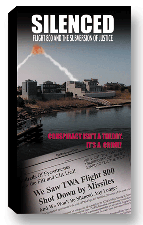How Obama’s Security Advisor Disarmed America
![]()
January 24, 2008 - WND.com
© Jack Cashill
by Jack Cashill
This is the fifth in a six-part series detailing the risks to American national security if Barack Obama (or Hillary Clinton) should ever choose to let Richard Clarke back into government. Clarke is currently one of Obama’s top national security advisors.
Half way into his 2004 bestseller, Against All Enemies, former Clinton counterterrorism czar Richard Clarke makes an oddly gratuitous claim.
Clarke insists that as a natural skeptic, “always intrigued by the possibility of the unlikely explanation,” he has pushed his fellow analysts to examine all angles in a given case, even those that seemed improbable.
As proof of his open-mindedness, Clarke observes with a straight face, “We had always looked for Iraqi involvement in the World Trade Center attack of 1993.”
As readers of either his book or this series can attest, Clarke did no such thing. Indeed, given the evidence, one would suspect that he was tasked with discrediting all inquiry into Iraqi involvement in the 1993 bombing.
Clarke inserts this exculpatory reference to the1993 World Trade Center attack into an extended discussion of a more haunting mystery, the destruction of TWA Flight 800 off the coast of Long Island on July 17, 1996.
Clarke does so to reinforce the idea that he approaches all such mysteries with a fully open mind. Ironically, however, by paralleling these two cases, he makes the opposite point, namely that his role was not to foster free inquiry but to fix sticky situations.
In case of TWA Flight 800, Clarke tells the reader that he chose not to dismiss out of hand the claims of former U.S. Senator Pierre Salinger that the airliner had been shot out of the sky.
Instead, Clarke investigated Salinger’s charges, only to conclude, “Salinger thought a U.S. Navy F-14 had shot down TWA 800 and he had a set of accompanying fantasies.”
In reality, Salinger never said or suggested that a Navy plane had downed the doomed aircraft. The scenario he did paint—that of a misguided Navy surface-to-air missile—was widely reported and not at all fantastic.
Clarke had to know this. But his role here, as with the 1993 WTC bombing, was to trivialize impolitic theories, especially those that fit the evidence more closely than the ones Clarke himself was fronting.
Giving credit where it is due, Clarke alone among Clinton officials has offered some useful background into the demise of TWA Flight 800 and what he has called “the Almost War, 1996.”
Clarke’s narrative, however, is not entirely trustworthy. One has to be a veritable student of the TWA 800 disaster—a schooling the major media have chosen to avoid—to distinguish the true from the false and the consciously false from the merely careless.
In July 1996, Clarke served as chairman of the Coordinating Security Group on terrorism (CSG). In his book, he reports that he was in the process of convening a meeting of that group in the White House situation room within thirty minutes of the plane’s crash.
He suggests that the CSG meeting was necessary because “many” in a joint Coast Guard and Air Force exercise off Long Island actually “saw a huge fireball in the sky east of the island at about fifteen thousand feet.”
“The FAA,” Clarke continues, “was at a total loss for an explanation. The flight path and the cockpit communications were normal. The aircraft had climbed to 17,000 feet, then there was no aircraft.”
In fact, it was the FAA that initiated the meeting. The eyewitness reports would come in later. FAA radar operators in New York had seen on their screens an unknown object “merging” with TWA 800 in the seconds before the crash and rushed the radar data to Washington.
Indeed, when Ron Schleede of the NTSB first saw the FAA data, he exclaimed, “Holy Christ, this looks bad.” He added later, “It showed this track that suggested something fast made the turn and took the airplane.”
Incorrect too is the altitude Clarke cites. As the FAA knew and reported, TWA 800’s last recorded altitude was about 13,800 feet.
Although Clarke cites 17,000 feet as the maximum altitude in this particular reference, he cites 15,000 feet in two others. The discrepancy between the two elevated altitudes is likely due to carelessness, but the elevation is likely not.
“[TWA 800] was at 15,000 feet,” Clarke quotes himself as telling the FBI’s John O’Neill. “No Stinger or any other missile like it can go that high.”
By elevating the plane above its actual peak altitude, Clarke not only attempts to take missiles out of play, but he also tries to absolve himself of any responsibility for the plane’s destruction.
Forget Charlie Wilson or Bill Casey, in Against All Enemies the extravagantly boastful Clarke takes credit for providing the Afghan resistance with shoulder-fired Stinger missiles in their struggle against the Soviets.
Although at least 24 civilian aircraft have since been shot down by surface-to-air missiles, Clarke assures the reader with more confidence than the evidence can bear, “None [of the Stingers] were ever used by terrorists,” certainly not in Long Island on July 17, 1996.
In the real world, of course, any number of missiles can go much higher than 15.000 feet. In October 2001, for instance, a Ukrainian surface-to-air missile accidentally shot down a Russian airliner at about 35,000 feet.
Still, taking Clarke at his word, for the first weeks after TWA 800’s demise, he shared the president’s concern that terrorists had taken out the airliner.
“I knew he thought it was a terrorist act,” Clarke writes of Clinton a week after the crash, “and he was bracing himself for what he would have to do in response.”
Three weeks prior, terrorists had blown up the Khobar Towers in Saudi Arabia, killing 19 American servicemen. In response, as Clarke explains, President Clinton “wanted a massive attack that would frighten the Iranians into inaction” should they strike again.
Clarke tells the reader he “dreaded” that response, what the CSG called, “the Eisenhower Option.” The president did too. Less than four months before an election that he already had in the bag, one that he had desperately scrambled to secure, the Eisenhower Option was simply not good politics.
As in the case of the 1993 World Trade Center bombing, it would be politically useful to find some explanation other than state sponsored terrorism for the destruction of TWA 800, other than terrorism at all, if possible.
Not surprisingly, it was the ever-resourceful fixer, Richard Clarke, who would almost miraculously discover that explanation.
Unfortunately for America, Clarke’s fix would leave our doors open to the terrorists of September 11 five years later.
But, fortunately for Clarke, that was just enough time to shift the blame to the incoming administration, the one that dared to demote him.
Next week: Did Clarke's "Almost War" cause the real one?

Previous articles in this series:
![]()
![]()
Get more info:

- About Mega Fix: The Dazzling Political Deceit that Led to 9/11 (DVD) -
- Buy the Mega Fix DVD -
![]()

- About Silenced: Flight 800 and the Subversion of Justice (DVD) -
-Buy the Silenced DVD-
![]()
Part 2
Part 3
Part 4
Part 5
Part 6
